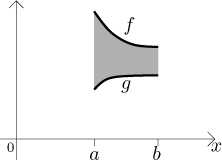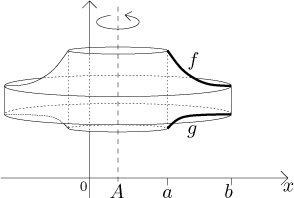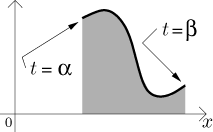
Consider the region R bounded from above by the graph of a function
f and from below by the graph of a function g on an interval

Consider the solid obtained by rotating the region R about a
horizontal axis of rotation given by

Its volume is equal to
![]()
Consider the solid obtained by rotating the region R about a
vertical axis of rotation given by

Its volume is equal to
![]()
More complicated regions have to be decomposed into regions of the above type.
Example: Consider the region under the graph of
Solution: We start with a picture:

We see that in fact we have a region bounded from above by the function

If the integral is too difficult, sometimes it helps to switch the axes (see Area). Actually, our example above was easy, but we will use it to show the axes switching anyway. We turn the picture around the diagonal, changing to inverse function for the graph:

We see that we have to divide the rotated region into two parts. First, we
rotate a rectangle between functions

Adding these two volumes together we get the total:
![]()
This way it was more difficult. After gaining some experience, it is usually easy to see from the shape of the region whether it pays off to switch the axes.
Just like with the area, there are two possible approaches to finding the volume. One is to remember the above pictures and formulas and apply them, which may get a bit confusing in more complicated situations. The other approach is to remember the idea behind the disc and shell methods, that is, the trick with thin revolving stripes, and apply it to a given problem. This approach, when mastered, may be easier especially in the situation when we would like to switch axes. We show it in this solved problem.
Consider a parametric curve

The volume of the solid obtained by revolving this region about a horizontal
axis of rotation given by
![]()
The volume of the solid obtained by revolving this region about a vertical
axis of rotation given by
![]()
Surface of a solid of revolution
Back to Methods Survey - Applications